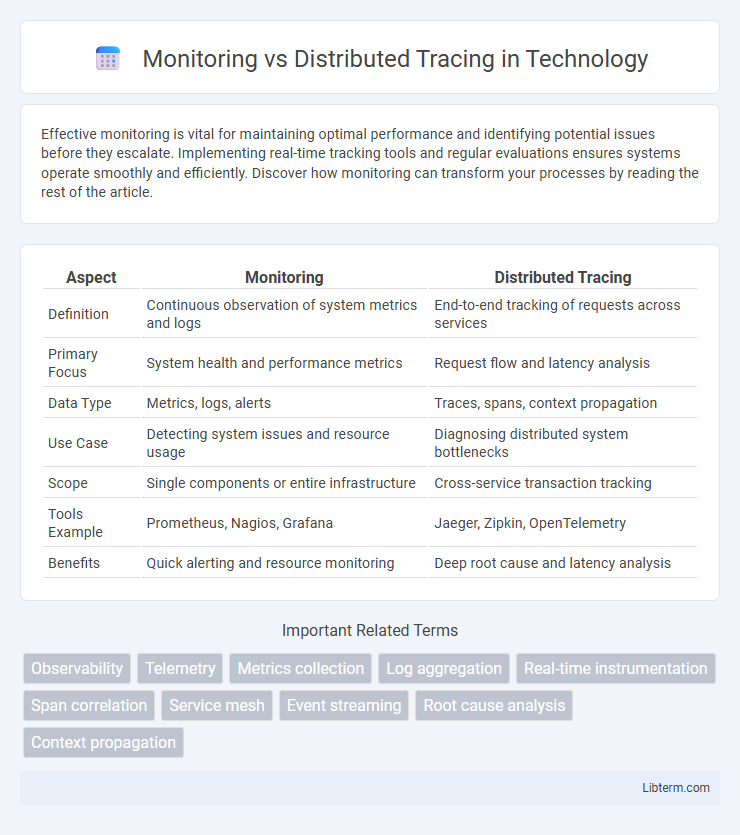Effective monitoring is vital for maintaining optimal performance and identifying potential issues before they escalate. Implementing real-time tracking tools and regular evaluations ensures systems operate smoothly and efficiently. Discover how monitoring can transform your processes by reading the rest of the article.
Table of Comparison
| Aspect | Monitoring | Distributed Tracing |
|---|---|---|
| Definition | Continuous observation of system metrics and logs | End-to-end tracking of requests across services |
| Primary Focus | System health and performance metrics | Request flow and latency analysis |
| Data Type | Metrics, logs, alerts | Traces, spans, context propagation |
| Use Case | Detecting system issues and resource usage | Diagnosing distributed system bottlenecks |
| Scope | Single components or entire infrastructure | Cross-service transaction tracking |
| Tools Example | Prometheus, Nagios, Grafana | Jaeger, Zipkin, OpenTelemetry |
| Benefits | Quick alerting and resource monitoring | Deep root cause and latency analysis |
Understanding Monitoring: Definition and Scope
Monitoring involves continuously collecting and analyzing metrics, logs, and events to track the health and performance of IT systems in real time. It provides a broad overview of system status, resource utilization, and error rates, enabling rapid detection of anomalies and outages. Effective monitoring covers infrastructure, applications, and network components to ensure comprehensive visibility into operational status across the environment.
What is Distributed Tracing? Key Concepts
Distributed tracing is a method used to track and observe requests as they flow through various services and components in a distributed system, providing deep visibility into complex microservices architectures. Key concepts include spans, which represent individual operations within a trace; trace IDs, which uniquely identify the entire request journey; and context propagation, which carries trace information across service boundaries. This approach allows for pinpointing performance bottlenecks, understanding dependencies, and diagnosing failures in real-time across multiple services.
Core Differences Between Monitoring and Distributed Tracing
Monitoring involves the continuous collection and analysis of metrics and logs to assess the overall health and performance of an entire system. Distributed tracing focuses on tracking individual requests across multiple services, providing detailed insights into the flow and latency of transactions within complex microservices architectures. While monitoring offers a broad overview through aggregated data, distributed tracing delivers granular visibility into specific service interactions and pinpointing bottlenecks.
When to Use Monitoring vs Distributed Tracing
Monitoring is crucial for continuously tracking system performance metrics such as CPU usage, memory consumption, and uptime to detect anomalies and maintain overall health. Distributed tracing excels when pinpointing specific requests or transactions across microservices, helping identify latency bottlenecks and pinpoint failure points in complex architectures. Use monitoring for real-time alerts and system-wide visibility, while distributed tracing is ideal for in-depth analysis of request flows and root cause investigation during performance issues.
Benefits of Monitoring in Modern Systems
Monitoring in modern systems provides real-time visibility into system performance, enabling rapid detection and resolution of issues before they impact users. It offers essential metrics such as CPU usage, memory consumption, and network latency, which help maintain system stability and optimize resource allocation. Continuous monitoring supports proactive system management, reducing downtime and enhancing overall reliability in complex distributed environments.
Advantages of Distributed Tracing in Microservices
Distributed tracing provides precise visibility into complex microservices architectures by tracking requests as they propagate through various services, enabling faster identification of performance bottlenecks and failure points. It offers granular, end-to-end insights into individual service interactions, which traditional monitoring tools often miss, improving root cause analysis and reducing mean time to resolution (MTTR). With distributed tracing, teams gain comprehensive contextual data that enhances debugging, optimizes resource allocation, and supports seamless scalability in dynamic cloud-native environments.
Integrating Monitoring and Distributed Tracing: Best Practices
Integrating monitoring and distributed tracing enhances observability by combining system-wide metrics with detailed request-level insights, enabling faster root cause analysis and performance optimization. Best practices include centralizing data collection through platforms like Prometheus and Jaeger, correlating logs, metrics, and traces using consistent trace IDs, and automating alerting based on trace anomalies or latency spikes. Leveraging AI-driven analytics further refines anomaly detection and predictive maintenance in complex microservice architectures.
Common Tools for Monitoring and Distributed Tracing
Prominent monitoring tools such as Prometheus and Nagios excel at collecting system metrics, alerting on abnormalities, and visualizing performance data. In contrast, distributed tracing solutions like Jaeger and Zipkin specialize in tracking requests across microservices, revealing latency bottlenecks and tracing the end-to-end flow of transactions. Combining these tools enhances observability by correlating infrastructure metrics with detailed trace data for comprehensive analysis.
Challenges in Implementing Observability Solutions
Implementing observability solutions faces challenges such as managing large volumes of telemetry data and integrating diverse data sources for monitoring and distributed tracing. Ensuring low-latency data collection while maintaining system performance requires scalable infrastructure and efficient data processing pipelines. Security and data privacy concerns, along with the complexity of correlating distributed traces across microservices, also pose significant obstacles in achieving effective observability.
Future Trends in Monitoring and Distributed Tracing
Future trends in monitoring and distributed tracing emphasize increased integration of AI and machine learning to predict system anomalies and automate issue resolution. Enhanced observability platforms will combine metrics, logs, and traces into unified dashboards, improving root cause analysis accuracy and reducing mean time to recovery (MTTR). Edge computing and microservices architectures will drive the evolution of lightweight, real-time tracing solutions optimized for scalability and minimal performance overhead.
Monitoring Infographic

 libterm.com
libterm.com